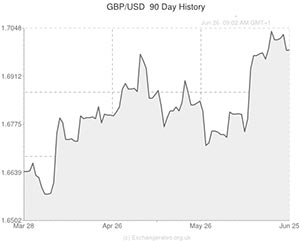
It has been a busy fortnight for the Pound to US Dollar exchange rate (GBP/USD).
On 12 June, 2014 Sterling shot up the currency ladder in response to comments from Bank of England Governor Mark Carney suggesting that interest rates could be raised before the end of the year. GBP/USD rallied above longstanding psychological resistance at 1.7000 to reach a fresh 5.5-year high of 1.7063 in response.
However, on Tuesday 24 June, 2014 Sterling plunged back below 1.7000 as Carney indicated that there was still too much slack in the UK economy and wages are still not rising fast enough to justify an interest hike at this moment in time.
The GBP to USD rollercoaster ride continued yesterday afternoon when it was reported that US annualised GDP shrunk by a whopping -2.9% in the first quarter. The shocking result marked the largest ever downward revision – the government initially reported that the economy only contracted by -0.1% – and represented the worst growth score since 2009. The freezing weather conditions weighed heavily on Gross Domestic Product but it is believed that only -1.5% of the contraction was directly related to the polar vortex.
In reaction to the dismal figure Sterling rallied by around a third of a cent to briefly breach the 1.7000 handle once more. However, GBP/USD failed to sustain itself above that level during the afternoon.
Confusing US data
The knee-jerk reaction to the terrible GDP numbers was to sell the US Dollar as traders interpreted it to mean that the Federal Reserve will probably avoid raising interest rates for a considerable amount of time.
However, later on in the afternoon it was reported that the US services industry expanded at a record pace during June. Markit’s service sector PMI report featured robust readings for new business, job creation and price pressures, which helped drive the headline indicator from 58.1 to 61.2. This marked the highest score since the survey began 4.5 years ago.
With recent labour market figures coming in positively, private sector growth at its highest level since the onset of the financial crisis and housing market indicators also impressing it is looking increasingly likely that the US economy will post a much stronger GDP score for the second quarter. Estimates suggest that the world’s largest economy will rebound by at least 3.0% in Q2.
This is likely to cause some policymakers at the Federal Reserve to start sounding more hawkish with regards to monetary policy and this could help drive demand higher for the ‘Greenback’.
It looks like the Pound to US Dollar exchange rate could fluctuate around the 1.7000 level for some time to come as investors fret over the timing of interest rate rises from the Bank of England and the Federal Reserve.
The BoE is likely to start raising rates considerably sooner than the Fed, which means that British data is liable to have a more protracted impact on GBP/USD over the next few weeks. Any positive indicators could boost the Pound, whilst any negative results could send the US Dollar higher.
UPDATED 06:40 GMT 27 June 2014
Pound to US Dollar (GBP/USD) Exchange Rate Continues above $1.70
The Pound to US Dollar (GBP/USD) exchange rate pushed above $1.70 yesterday in response to the UK Financial Stability report and was able to consolidate gains after the US Personal Spending figures fell short of forecasts.
Personal spending in the world’s largest economy was up 0.2% last month rather than the 0.4% expected.
The Pound to US Dollar (GBP/USD) exchange rate was little changed after Federal Reserve Bank of St Louis President stated that he believes the US economy is strong enough to withstand an interest rate increase in 2015.
Later today UK first quarter growth figures and the US University of Michigan Consumer Confidence index could spark movement in the Pound to US Dollar (GBP/USD)exchange rate.

Comments are closed.